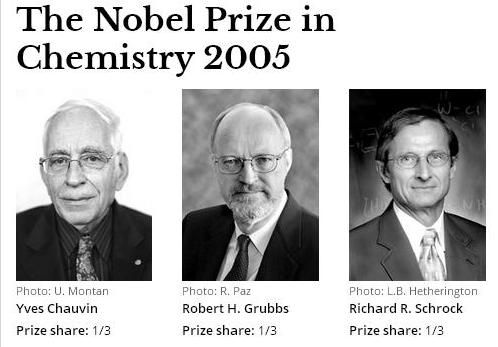The Nobel Prize in Chemistry this year goes to Yves Chauvin, Robert Grubbs and Richard Schrock. They have developed an efficient and environmentally-friendly method of building new molecules, with applications in, e.g., the pharmaceuticals industry.
The Royal Swedish Academy of Sciences has decided to award the Nobel Prize in Chemistry for 2005 jointly to
Yves Chauvin, Institut Français du Pétrole, Rueil-Malmaison, France,
Robert H. Grubbs, California Institute of Technology (Caltech), Pasadena, CA, USA and
Richard R. Schrock, Massachusetts Institute of Technology (MIT), Cambridge, MA, USA
“for the development of the metathesis method in organic synthesis”.
Metathesis – a change-your-partners dance
This year’s Nobel Prize Laureates in chemistry have made metathesis into one of organic chemistry’s most important reactions. Fantastic opportunities have been created for producing many new molecules – pharmaceuticals, for example. Imagination will soon be the only limit to what molecules can be built!
Organic substances contain the element carbon. Carbon atoms can form long chains and rings, bind other elements such as hydrogen and oxygen, form double bonds, etc. All life on Earth is based on these carbon compounds, but they can also be produced artificially through organic synthesis.
The word metathesis means ‘change-places’. In metathesis reactions, double bonds are broken and made between carbon atoms in ways that cause atom groups to change places. This happens with the assistance of special catalyst molecules. Metathesis can be compared to a dance in which the couples change partners.
In 1971 Yves Chauvin was able to explain in detail how metatheses reactions function and what types of metal compound act as catalysts in the reactions. Now the “recipe” was known. The next step was, if possible, to develop the actual catalysts.
Richard Schrock was the first to produce an efficient metal-compound catalyst for methasesis. This was in 1990. Two years later Robert Grubbs developed an even better catalyst, stable in air, that has found many applications.
Metathesis is used daily in the chemical industry, mainly in the development of pharmaceuticals and of advanced plastic materials. Thanks to the Laureates’ contributions, synthesis methods have been developed that are
more efficient (fewer reaction steps, fewer resources required, less wastage),
simpler to use (stable in air, at normal temperatures and pressures) and
environmentally friendlier (non-injurious solvents, less hazardous waste products).
This represents a great step forward for ”green chemistry”, reducing potentially hazardous waste through smarter production. Metathesis is an example of how important basic science has been applied for the benefit of man, society and the environment.
Yves Chauvin, born 1930 (74 years), French citizen. Directeur de recherche honoraire à l’Institut français du pétrole, Rueil-Malmaison, France.
Robert H. Grubbs, born 1942 (63 years) in Calvert City, KY, USA (US citizen). PhD in chemistry in 1968 from Columbia University, New York, NY, USA. Victor and Elisabeth Atkins Professor of Chemistry at California Institute of Technology (Caltech), Pasadena, CA, USA.
Richard R. Schrock, born 1945 (60 years) in Berne, IN, USA (US citizen). PhD in chemistry in 1971 from Harvard University, Cambridge, MA, USA. Frederick G. Keyes Professor of Chemistry at Massachusetts Institute of Technology (MIT), Cambridge, MA, USA.
The Prize amount: SEK 10 million, will be shared equally among the Laureates
